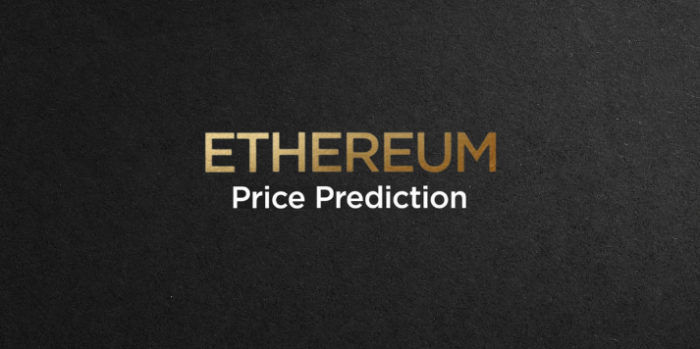
Ethereum Price Prediction for 2022 and Beyond
- Why Ethereum Arguably Does Better Than Bitcoin
- Ethereum: an Overview
- ERC-20: Tokens Made by Anyone
- What’s Next for Ethereum?
- Ethereum Futures: More Excitement Up Ahead
- A Look Back Into Ethereum’s Price History
- ETH Price Prediction 2022 - 2023
- Ethereum’s Technology So Far
- Is Ethereum a Good Long-term Investment?
- Frequently Asked Questions
-
- Is Ethereum a Cryptocurrency?
- Who Created Ethereum?
- How Can I Mine Ethereum?
- How Will the Transition to Proof-of-Stake (PoS) Affect Mining?
- How Much Is 1 ETH Worth?
- What Will Ethereum Be Worth in 2025?
- How Is Bitcoin Different From Ethereum?
- Which Is Better: Ethereum or Bitcoin?
- Can Ethereum Overtake Bitcoin?
The Ethereum blockchain uses Ether (ETH) as its cryptocurrency. Ranking at #2 in the top market cap, ETH continues to dominate thanks to its loyal investors, active team, ongoing progress to improve the blockchain and the constant good news surrounding it. As speculators analyze, ETH may even overtake Bitcoin (BTC) within the next decade - given that BTC’s won’t change for the better. On November 10, 2021, ETH hit the newest all-time high of $4,868, stacking up more than 500% since its price opening of $736 in January 2021.
As more investors flock to ETH and with more ambitious improvements for Ethereum, it seems like a continuous positive outlook for the #2 cryptocurrency in the world. Will we see closure of $10K (or perhaps higher) at the end of next year? Let’s find out in our Ethereum price prediction 2022 and 2023.
Why Ethereum Arguably Does Better Than Bitcoin
Let’s face it: Bitcoin may have set the grounds for a new generation in the financial market and created a possibility of transactions without the prying eyes of the state and bank but it comes with plenty of problems.
Yes, the investors since the mid-2010s may have made millions of dollars today. However, there’s no denying that the overall technology of Bitcoin suffers from several significant issues where Ethereum pinpoints these problems to create solutions.
The Ongoing Bitcoin Issue
One of which is energy consumption. According to Fortune, did you know that Bitcoin leaves a large carbon footprint? For every BTC transaction, it consumes 1,173 kilowatt-hours of electricity. That’s enough power to provide electricity to a standard home for a month and two weeks.
Not only do the transactions eat that much power, but mining poses a problem as well. One successful mining consumes around $176 worth of electricity. In 2021, Bitcoin became less eco-friendly thanks to more people doing transactions within its local blockchain. This result may have led Elon Musk to upload the infamous tweet that caused the biggest crypto crash of 2021 last May.
Could Ethereum Fix All of Bitcoin’s Problems?
Everyone in the crypto sphere knows the capability of Ethereum: it’s Bitcoin 2.0 without piling up on the constant problems. While the Ethereum blockchain may lead to its own problems, they are fixable and not as big as Bitcoin.
Ethereum’s very first solution is faster transactions. It’s already been proven what the Ethereum blockchain can outdo over Bitcoin. The proof could have been the catalyst behind bigger trading volumes lately in ETH over BTC. Another remarkable feature of ETH is its cheaper transaction fees. Compared to BTC, ETH transactions are significantly simpler and more affordable.
The only underlying problem of Ethereum is its battle against gas fees. A gas fee can take a huge cut on the total amount the sender will pay or the receiver will claim because every transfer requires a form of toll to complete the transaction. This gave birth to the establishment of the ERC-20 which lets developers create a legitimate token with full customization. The forked Ethereum tokens brought in a new wave of investors as well.
With the ERC-20, devs can now edit the code for smart contracts in case they make an error - whether big or small. This minimizes the financial losses unlike BTC’s uneditable smart contracts. Also, transactions are way faster as well. This technology also help developers have their tokens listed in the most popular crypto exchanges. The altcoin numbers soon doubled the moment Ethereum made ERC-20 a standard for the most optimal tokenization tool and currency transfers.
Above all else, Ethereum does not take as much electricity as Bitcoin. Its mining power also makes it safer for less powerful computers to harvest ETH than harvesting BTC.
A lot of people are positive that ETH will overtake BTC in the future after so many proofs that the #2 cryptocurrency can dethrone the original. But, we will leave time to determine its fate (and its holders).
Ether (ETH) is the cryptocurrency that powers the Ethereum blockchain. It had one of the most successful runs in the 2021 start-of-year bear market, closing in on an all-time high of $1,439. Its 67% year-to-date (YTD) gain brought in eager novice investors looking for a more robust alternative to Bitcoin. With big news surrounding Ethereum 2.0, Ether Futures, and the blockchain’s Proof of Stake migration, investors are closely watching out for how the Ethereum price prediction will fare in the current and future market.
Ethereum: an Overview

Ethereum was launched in 2015 and immediately blew up in popularity due to its unique proposition as an open-source platform for decentralized applications, landing it the #2 spot on the market–second only to Bitcoin. It never left that spot since. In the following years, other altcoins–including EOS and Cardano–started to emerge and proposed a similar value to Ethereum. But the latter remained the most popular–and it still is today.
Ethereum has always stayed one step behind the cryptocurrency frontrunner, Bitcoin currency, and has always been the most successful altcoin by market cap. While it hasn’t been able to take down Bitcoin’s giant fortress built by investors and enthusiasts, Ethereum isn’t just a coin on display, either. Its blockchain network can do what Bitcoin does: make financial transactions, but a little more efficiently. And that’s not all.
Ethereum’s system can do a whole lot more. The first cryptocurrency-backed network allowed developers to create decentralized applications (DApps) and tokens on the Ethereum blockchain. It’s also powered by a virtual machine that can run smart contracts, which are automated actions that will run when certain conditions are met. Smart contracts are essential in fostering peer-to-peer transactions without relying on a third-party intermediary.
These functionalities fall in line with Ethereum’s goal of decentralizing the internet–by offering everyone the opportunity to jump in on that wave.
ERC-20: Tokens Made by Anyone
While Ether (ETH) is the native token in the Ethereum blockchain, the latter’s system is robust enough to support the creation and management of other tokens. It became an important catalyst for other altcoins to emerge as anyone can create a coin on the blockchain. These tokens can represent a virtual currency or other transactional assets, such as loyalty points and company shares. They can be created through smart contracts, which will dictate all the functions that allow the tokens to function as cryptocurrency.
However, there were a couple of issues with this freeform token creation system. First, because everyone wrote smart contracts differently, each coin ended up with a unique code that cryptocurrency exchanges and wallets didn’t already support. For these coins to make it to the public market, exchanges had to put in extra work to support their code. Second, because smart contracts can’t be edited or tampered with after being rolled out, bugs found too late couldn’t be fixed. So if a developer were to miss a critical error in the code, it opened plenty of opportunities for bugs to break out, and could result in huge financial losses.
As a solution to the issue, the Ethereum community created a guideline for token creation, with six mandatory functions to ensure that the token works like it should: the ERC-20. That way, cryptocurrency exchanges, and wallets only had to enable support for one type of code, and any token created under this standard could easily make it to the major platforms.
But the ERC-20 isn’t a gold standard–it’s just a guideline that developers can implement however they liked. As a result, it didn’t eliminate all instances of smart contracts bugging out and causing people to lose tokens. As a workaround, the community rolled out the ERC-223 and ERC-777, which are standards that allow tokens to have the same functions as ETH.
Ethereum’s ability to support other tokens has paved the way for other big players to leverage their way up the cryptocurrency market. Over 30,000 tokens live in the Ethereum blockchain, including many of the top 100 coins by market cap. This function sets Ethereum apart from other blockchains, and its stability and the community’s support and interest are important in influencing the Ethereum price forecast for 2021.
The Problem With Ethereum
While Ethereum runs against a trail of success, its platform isn’t perfect. One of its biggest shortcomings is scalability. It can only process up to 15 transactions per second (tps), falling short of Dash’s 56 tps and EOS’s 1000+ tps. With Ethereum’s speed, it can hardly rival third-party intermediaries, such as VISA, which has the capacity of processing upwards of 50,000 tps.
This limitation became clear in 2017 when the infamous Cryptokitties game was launched on the Ethereum blockchain. It allowed people to create, breed, and trade one-of-a-kind kitties completely with a 256-bit genome with unique genetic sequences. The pokemon-eiscue trading game became an internet sensation, with people reportedly spending over $1 million on virtual kitty pngs. Thousands of kitties were being transacted by the second, but Ethereum’s 15 tips couldn’t keep up, causing transaction fees to soar sky-high and bugs to clog the network. That was a clear wake-up call that something had to be done to make Ethereum usable on a large scale.
What’s Next for Ethereum?
At the end of 2020, Ethereum dropped huge announcements revolving around its platform–a major upgrade called Ethereum 2.0.
It promises to address scalability by improving transaction speeds and efficiency by introducing a sharding system. The blocks that make up the network are called beacon chains. These are where transactions are being stored and processed. But with the new update, a parallel line of chains called shard chains will be introduced. Shard chains will take on a portion of the beacon chain’s work, such as adding new blocks and validating transactions. Meanwhile, the beacon chains will “manage” the shard chains and ensure that they’re doing their job and are up-to-date.
By the looks of it, the sharding system will be a solution to the longstanding transaction speed issue as it decongests the primary blocks by splitting up the work into more manageable loads. Critics are closely watching this development as it will make or break Ethereum’s future in terms of scalability and capacity for mass adoption. From an investors’ perspective, you may want to look out for news concerning the sharding system as it will greatly affect the Ethereum future predictions from 2021 to 2025.
Another big change that will come with Ethereum 2.0 is a shift from the Proof-of-Work (PoW) mining system to the Proof-of-Stake (PoS). The PoW system was a power-hungry process where everyone’s rigs race to complete complex math problems and win the token reward. In contrast, the PoS replaces the power resource with financial collateral of 32 ETH that miners would have to commit to the network. It eliminates the need for powerful rigs as the process can be done on a normal computer.
Ethereum 2.0 will be rolled out in 3 phases. Phase 0, or the beacon chain, was released in December 2020, and the rest are expected to come by 2021-2022. Until then, the market remains excited about the future of the token.
Ethereum Futures: More Excitement Up Ahead
The Ethereum hype train just keeps on running. In December 2020, the Chicago Mercantile Exchange (CME), the world’s biggest platform for derivatives, announced that it would start trading Ether Futures on February 8–granted that all goes well with the US authorities.
Futures represent a legal contract wherein two parties are expected to transact a trade between assets at a predetermined date and price. This launch was due to the explosive popularity of Bitcoin Futures and offers another option for ETH investors. It’s expected to play a huge role in the possible upward trend of Ethereum prices in the future.
A Look Back Into Ethereum’s Price History
Ethereum was first launched in cryptocurrency exchanges in 2015 when it was trading for under $1. While the cryptocurrency brought huge market interest due to its unique value proposition, its value remained at the $10 mark until the end of 2017. However, in 2018, Ethereum entered its most legendary bear market with a price spike to over $1,400–a 13,000% increase in the past year alone.
That price hike was due to corporate interest in Ethereum’s technology. It fell in line with the increasing popularity of decentralized financial technology. Investors were also looking for other altcoins to put their money into. Around the same time, tokens like Ripple (XRP) also saw a massive price increase.

However, as with any other sudden price hike, Ethereum’s sky-high success didn’t last, and it soon plummeted to $87 by the end of 2018. It recovered to the three-digits but remained under $500 under late 2020, when a surge of developments surrounding Ethereum 2.0, Ether Futures, and Bitcoin’s huge bull run brought prices past the $600 mark, and eventually the $1,000 point.
ETH Price Prediction 2022 - 2023
Whether you support and invest for its technology or only for the sake of safer trades, ETH has done a massive bullish run since the beginning of 2021. As of this writing, ETH is floating between $3,503 and $4,778.
After the Bitcoin price crash of December 4, 2021, It seemed like ETH was not entirely affected by the decline for several days until the token eventually coped with the consolidation. Looking at the bigger chart, you can see that ETH is still in a bull run and more people are willing to invest in its current price. ETH became one of the most outstanding altcoins this year, hitting a massive 500% profit since its lowest price of $714.29 in January.
Current state of its chart indicates that it is continuously going up. Therefore, December marks its accumulation period of more buyers just like the recent downs of May and September of the same year.
If you are still starting out on crypto, ETH may seem like the safer choice compared to the hundreds of altcoins simply because it is:
- Popular among the community
- Showing an awesome track record of proof of use
- A highly active development team
- High-profile corporations showing positive feedback towards Ethereum
- More developers utilizing its technology for NFTs and digital assets
With such great reviews towards ETH, we should expect its end-of-year price in 2022 with around $12,000 - given that the Bitcoin dominance does not bring up a bear market. If things go well by 2023 and plenty of businesses utilize ETH as part of the norm, the price may reach up to $24,000 and beyond. As Vitalik - co-founder of Ethereum - said, it could “explode to 100k.”
What Will Affect Ethereum Prices?
The Positive
Ethereum is currently the most popular platform for building decentralized applications and tokens. Because a varying number of ETH is required to sustain third-party development, a boom in Ethereum’s usage will positively affect ETH prices.
There is a government, corporate, and personal interest in decentralized finance (Defi), partly due to the pandemic's digital shift. People are paying more attention to the Defi sector, of which many of its applications were built on the Ethereum blockchain.
Additionally, Ethereum is in an active stage of development toward Ethereum 2.0 cryptocurrency. This upgrade will greatly change the way the platform processes transactions and the way ETH is mined. The interest in Ethereum 2.0 and its successful rollout will be positive for ETH prices.
Apart from Ethereum’s developments, ETH has also retained its spot as the most popular altcoin by market cap. It naturally attracts novice investors and is a top pick for anyone looking into exploring altcoins.
The Neutral
Compared to the rest of the coins, ETH did not have the same massive price hike as the likes of the meme Dogecoin and its rival Shiba Inu or the Metaverse craze of Sandbox and Decentraland. However, that also shows that ETH is steadily going into a more “stable” state than its more volatile earlier days.
ETH also provides a rather regulated activity than other altcoins, making this a mixed reception for those escaping the stock exchange’s strict centralized security.
The Negative
Competition may lead to the downfall of ETH as well. 2021 showed the potential of the Terra Luna token, Polkadot’s DeFi technology, and the fan-favorite Cardano. These competitors not only show better quality-of-life changes for transactions, but they also aim to provide better services than Ethereum. If this keeps up and ETH cannot outdo its competition, it may just crumble from its number 2 spot and its investors migrate to the next big thing.
Ethereum’s Technology So Far
We witnessed the announcement of Ethereum 2.0 and an ambitious shift of the blockchain technology to turn from Proof-of-Work (PoW) to Proof-of-Stake (PoW). Not only does this bring in more positivity for Ethereum but it also significantly reduces the carbon footprint.
2020 saw the rise of decentralized finances (Defi), allowing users to perform financial transactions seamlessly. As Ethereum’s Defi sector continues to grow in 2021, analysts believe that it will help ETH’s price increase through the year. David Grider from Fundstrat Global Advisors believes that the bearish outlook doesn’t reflect the potential of Ethereum. He forecasts that ETH’s price can go up to $10,500 by the end of the year due to the Defi sector.
Additionally, the shift towards Ethereum 2.0 in December 2020 is also expected to fuel growth for 2021. This update will turn Ethereum into a self-sustaining financial ecosystem with easy scalability. Thus, the growth in user participation will likely grow even further this year.
Is Ethereum a Good Long-term Investment?
While ETH is a promising token to focus on in 2021, it’s impossible to say what the fast-moving cryptocurrency landscape will be like in the next year or two. For now, you may want to follow the news and continue to hold onto ETH as long as Ethereum continues its positive streak.
Moreover, external forces may also nullify the investment power of cryptocurrency. Some governments have raised their distaste for tokens and the concept of virtual currency. Therefore, any major bans or restrictions can be detrimental for ETH and the industry as a whole.
Frequently Asked Questions
Is Ethereum a Cryptocurrency?
Ethereum is an open-source blockchain network that runs smart contracts using Ether (ETH), the world’s second-largest cryptocurrency by market capitalization. With this network, developers can create decentralized applications to cut out third parties. Like other cryptocurrencies, Ethereum can also be used to make payments using ETH and other digital assets.
Ethereum uses the same technology as Bitcoin but has expanded capabilities since its platform offers a wider range of services. It has a coding language, payment system, and Internet browser, and is an open-source platform for anyone to create decentralized applications and tokens. ETH is the cryptocurrency that backs all of these functions and enables them to run.
Who Created Ethereum?
Vitalik Buterin is known as the creator of Ethereum. He first proposed the idea in 2013 after working on Bitcoin projects and seeing the potential of expanding Bitcoin technology. Through his experience with Bitcoin, he found that blockchain can be used for more than just peer-to-peer currency.
How Can I Mine Ethereum?
ETH can be mined using graphical processing units (GPUs). The hash rate of the GPU will determine how fast the mining device operates, so some miners create mining rigs, which consist of many GPU units.
Ethereum is currently mined through the Proof-of-Work (PoW) model, requiring all miners to complete a complex mathematical equation. The first to finish will win the token prize. Because this process is essentially a power-check, miners try to build the most powerful rigs possible, as more power will theoretically solve equations faster.
However, it’s important to know that Ethereum’s migration to Ethereum 2.0 will change the entire mining system to the Proof-of-Stake (PoS), which will no longer require the same powerful rigs.
How Will the Transition to Proof-of-Stake (PoS) Affect Mining?
The shift to PoS in Ethereum 2.0 will change the methods and requirements needed to validate the network. Miners will be referred to as validators, and with PoS, the goal is to create a more level playing field for more validators to participate.
In the proof-of-work (PoW) setting, miners use hash power to confirm blocks, but in the PoS setting, validators will stake 32 ETH. If a validator doesn’t stay online and fulfill their responsibilities, they get fewer block rewards. This feature incentivizes them to be online as much as possible. Additionally, if a validator maliciously corrupts the network in any way, all or a part of their 32 ETH will be confiscated.
People who wish to stake less than 32 ETH can also join a staking pool. Several ETH holders collate their funds to reach the required 32. Then their rewards will be divided proportionally based on their contribution.
This staking process doesn’t require miners to fight over who completes the equation first, making it a less power-hungry alternative than the previous PoW model. The PoS mining process can be performed on an ordinary laptop.
How Much Is 1 ETH Worth?
ETH prices have been increasing since the end of 2021, when it rose past the $700 mark and started going over $1,000 on January 3, 2021. It exceeded $4,300 in May but quickly dropped by 50% down to $2,500 in July. In December 2021, it is within a trading zone of $3,500 and $4,700.
Analysts are optimistic about the investment potential of Ethereum in 2022 due to the extended capabilities that it offers. The price of ETH has grown by a massive total of 156,000% since its debut. With the update to Ethereum 2.0, more transactions are expected to be processed in the network.
The rising prices of ETH in 2021, coupled with the optimistic forecasts, have attracted much investor interest in cryptocurrency. While ETH may not have the largest market cap among cryptocurrencies, the Ethereum network presents much potential for the Internet’s future. Its decentralized nature allows users to roam freely and control their funds and information. It opens up doors of opportunities for new business models and services to exist in a digital world.
According to Crypto Rating, it may take another two or three years for Ethereum 2.0 to be fully implemented. Thus, during this time frame, the value of ETH will likely appreciate as it becomes more integrated with the cryptocurrency space. The biggest increase is projected to occur in 2024, when the network would have undergone all the improvements, making ETH a highly lucrative investment today.
What Will Ethereum Be Worth in 2025?
Currently, the predictions for the price of ETH by 2025 are highly variable. On the lower end, DigitalCoinPrice predicts that the price will be at about $2,222 by then. However, others believe it to be higher, with Simon Dedic’s $9,000 forecast and Crypto Rating’s $16,000 prediction.
As blockchain technologies continue to infiltrate the digital space, many analysts believe that the anticipated path of ETH will follow an upward trend. The next five years, in particular, will be critical due to the evolving Ethereum 2.0 network. The price of ETH will depend on how well Ethereum 2.0 lives up to its expectations and how well users adopt the blockchain network.
How Is Bitcoin Different From Ethereum?
Ethereum employs the same blockchain technology as Bitcoin but has more capabilities. Bitcoin is simply a digital payment solution, while Ethereum is a digital payment solution and an open-source blockchain network for building applications.
Which Is Better: Ethereum or Bitcoin?
None of the two is necessarily better since they have different applications and internal dynamics and can't be compared directly. Bitcoin aims to be a store of value, while Ethereum aims to create an ecosystem that eliminates third parties.
Crypto experts would liken Ethereum and Bitcoin’s comparison to comparing stocks from different sectors since they have different goals. The long-term growth for either of them will depend on their applications in the future. Bitcoin’s appeal lies in its strong brand name and the growing acceptance of the currency. Ethereum, on the other hand, has the potential to transform the digital space through its robust platform where anyone can create decentralized platforms and cryptocurrency tokens.
Can Ethereum Overtake Bitcoin?
Strictly speaking, Ethereum and Bitcoin are not competing in the same ecosystem. Since ETH is merely a product of the larger Ethereum network, its threat to Bitcoin is not a simple direct comparison. However, considering the current market performance, ETH isn't expected to overtake Bitcoin anytime soon.
ETH’s growth is driven by many factors like the strength of the Defi market and Ethereum 2.0. Thus, forecasts are mid-term bullish, but analysts believe that its price may also stagnate against Bitcoin. The differences between Ethereum and Bitcoin will also affect how the market matures since they each have unique challenges. For instance, government regulations restricting cryptocurrencies will negatively affect Bitcoin. However, these will not affect Ethereum since users can still use the platform for other services and applications.








Leave a Reply
54 comments
Add comment ×